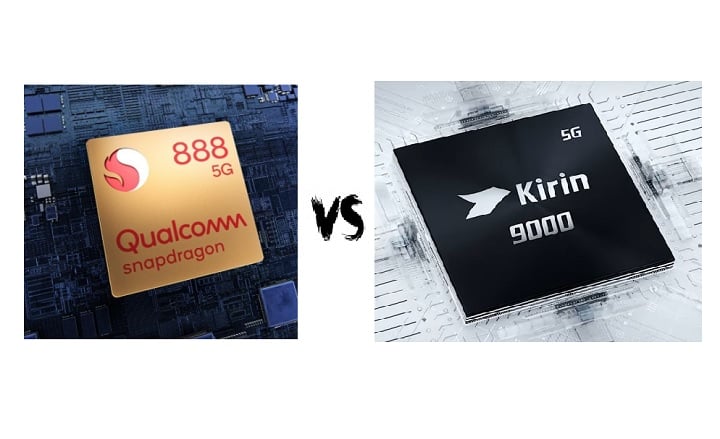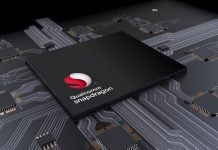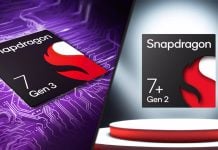The Snapdragon 888 launched earlier this week at the Qualcomm Digital Summit 2020. The 5nm processor will power next year’s flagship phones from several manufacturers, a large percentage of which are Chinese. The new Snapdragon 888 joins the HiSilicon Kirin 9000 and Samsung Exynos 1080, the other two 5nm chips that have been announced for Android devices.
 We know our readers are curious as to which of these three chipsets is the best but at the moment, only the Kirin 9000 is found in a commercially-available phone, so the only way to compare these chipsets will be on “paper”. For this article, we will be comparing the Snapdragon 888 against Huawei’s most powerful chipset, the Kirin 9000.
We know our readers are curious as to which of these three chipsets is the best but at the moment, only the Kirin 9000 is found in a commercially-available phone, so the only way to compare these chipsets will be on “paper”. For this article, we will be comparing the Snapdragon 888 against Huawei’s most powerful chipset, the Kirin 9000.
The table below shows the major specs of the two processors:
| Processor | Snapdragon 888 | Kirin 9000 |
|---|---|---|
| Node | 5nm | 5nm |
| CPU | 1 x 2.84GHz (Cortex-X1) 3 x 2.4GHz (Cortex-A78) 4 x 1.8GHz (Cortex-A55) | 1 x 3.13GHz (Cortex-A77) 3 x 2.54GHz (Cortex-A77) 4 x 2.04GHz (Cortex-A55) |
| GPU | Adreno 660 | Mali-G78 (24-core) |
| ISP | Spectra™ 580 | ISP 6.0 |
| AI Engine/NPU | Hexagon 780 | Dual Big Core + Tiny Core NPUs |
| Modem | Snapdragon X60 5G | Balong 5000 5G |
| Connectivity | Wi-Fi 6E, Wi-Fi 6 | Wi-Fi 6+ |
CPU
The CPU configuration is the first major difference between the Snapdragon 888 and the Kirin 9000. Both processors are octa-core chipsets with the same 1+3+4 CPU core arrangement, however, save for the four Cortex-A55 efficiency cores, the rest are different.
The Kirin 9000 may be Huawei’s most powerful chipset but its prime core and three other performance cores are last-gen Cortex-A77 cores. When compared to the prime core of the Snapdragon 888 which is the Cortex-X1, and its performance cores which are Cortex-A78 cores, the Kirin 9000 has some catching up to do even though all of its cores are clocked higher.
According to Arm, the Cortex-A78 offers a 20% improvement in performance over Cortex-A77 while the Cortex-X1 offers a 30% improvement in performance over the Cortex-A77.
When it comes to performance tasks, the Snapdragon 888 should take the lead. However, for tasks relegated to the efficiency cores (Cortex-A55), the Kirin 9000 should be faster due to the cores’ higher clock speed.
Overall performance should show the Snapdragon 888 taking the lead.
GPU
Qualcomm may have won the CPU category but the Kirin 9000 is the winner when it comes to the GPU. The Adreno 660 is said to bring a 35% increase in performance over the previous generation but Huawei claims its Mali-G78 GPU boasts a 52% increase in performance over Qualcomm’s last-generation GPU which is present inside the Snapdragon 865 Plus.
Benchmark results indeed show that the GPU inside the Kirin 9000 is no joke. It scores 6261 points on the GPU benchmark app, 3D Mark, leaving the Adreno 650 GPU of the Snapdragon 865 Plus with a score of 4286 points in the dust. We expect the Adreno 660 to do significantly better but we doubt it will be able to outscore the Mali-G78.
AI
The Snapdragon 888 comes with the new Hexagon 780 AI Engine that boasts up to 26 TOPS in performance. The Kirin 9000 also features a powerful tri-core NPU (Dual Big Core + Tiny Core) and currently sits at the top of the AI benchmark table. Qualcomm’s processor is yet to get benchmarked but the semiconductor company promises big gains. It remains to be seen if it can challenge the Kirin 9000.
Conclusion
The Kirin 9000 and Snapdragon 888 definitely bring huge improvements to the mobile chipset space, especially in the Android ecosystem. However, they have their individual strengths, the sum of which determines which of them is the more powerful one.
The Snapdragon 888 wins in terms of CPU performance while the Kirin 9000 seems to be the one with the better GPU and AI capabilities. However, there are other factors to consider such as power efficiency where the Kirin 9000 already does excellently well as shown in our review video. So until there is an in-depth device-to-device comparison, we can’t say which chipset is the clear winner.
UP NEXT: Here’s why Qualcomm’s flagship chipset is named Snapdragon 888 instead of Snapdragon 875







